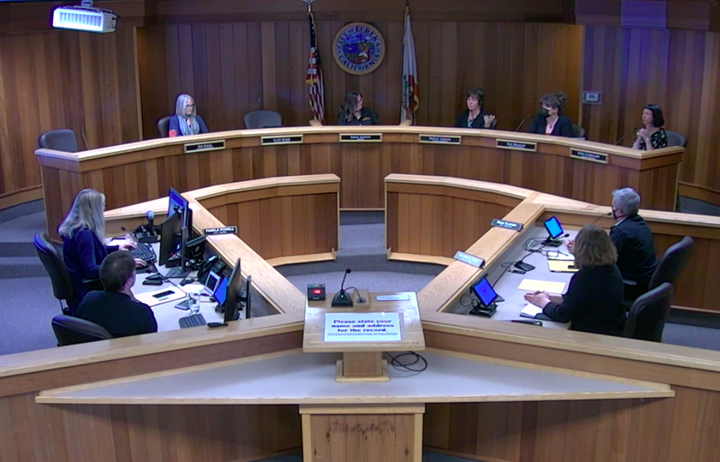The Eureka City Council convened for a special budget session on Tuesday evening. | Screenshot
###
After two years of significant budget cuts, the City of Eureka is expecting a $1.6 million budget surplus in the upcoming fiscal year. The Eureka City Council convened for a special meeting this week to take a look at the budget proposal for Fiscal Year (FY) 2022-23 and make recommendations as to how the extra cash should be allocated.
“I would point out that [the budget] surplus for Fiscal Year 2022-23 is an estimate,” Lane Millar, the City’s finance director, said during Tuesday’s meeting. “There is no guarantee that this will be what happens at the end of the fiscal year but typically our budgets are pretty close to what we start with, given that there are no pandemics or things of that nature.”
He noted that the $1,598,550 surplus could quickly shrink in certain circumstances. For example, the City will see expense increases later this year due to cost-of-living adjustment (COLA) pay increases. In addition, funds generated from Measure Z “are not guaranteed and could disappear in future years.”
Millar’s presentation focused on expenditures from individual departments within the General Fund, including the Eureka Police Department (EPD), Humboldt Bay Fire (HBF), Community Services, the City Manager’s office and Public Works.
Screenshot
Screenshot
Starting with EPD, Millar noted that the department’s budget is split into two divisions: police and communications/dispatch. Each division is projected to receive a nine percent and a ten percent budget increase, respectively. “Even with those increases, the police department is not seeing a very large increase mainly due to the fact that we’ve seen a lot of turnover,” he said. “When turnover happens you have new people fill positions that usually start at a lower step.”
HBF will likely see an 11% budget increase next year. “The reason why it’s not going up at a higher rate was because we’ve added employees,” Millar continued. “…If you’re the biggest department – like police or fire – and other departments add employees, you’ll actually see the cost allocation line items go down because those costs are being spread out among more people and other departments.
The budget for Community Services – including the Sequoia Park Zoo, park operations, recreation-youth programs and activities, administration, the Adorni Center, harbor operations and recreation-adult programs and activities – has increased “at a higher rate than average” that is being driven primarily by the zoo. Millar largely attributed the 45 percent increase to operational shifts at the zoo following the opening of the Redwood Skywalk.
Public Works has experienced “less growth than the average” and is projected to see a four percent increase next year.
“Public Works has a lot of divisions, but a lot of divisions with smaller budgets overall,” he said. Public Works covers administration, building-code enforcement, the Emergency Operations Center, engineering, stormwater, streets/alley maintenance and traffic/signals. “…We’re seeing people being moved around from one division to the other.”
The City Manager’s divisions – development and Community Access Project for Eureka (CAPE) – are expected to increase by 33 percent. Millar attributed the vast majority of the growth in the department to grant-funded positions.
The main takeaway from the overall budget proposal is that there are no major changes from the current fiscal year and both revenues and expenditures have leveled off, according to Millar. “I think the objective going forward, due to the fact we have a very healthy surplus, is identifying a new reserve objective in order to achieve long-term fiscal sustainability and to avoid cutting services during economic downturns.”
The council discussed the possibility of using a slice of the budget surplus (approximately $75,000) for participatory budgeting and community projects.
“One thing about the participatory budgeting that I love is that it gets people in our community engaged,” said Councilmember Kim Bergel. “It brings forward this pride of ownership and…it really sets a narrative and it sets up an opportunity for people to feel empowered and involved.”
Councilmember Leslie Castellano also expressed her support for participatory budgeting but suggested a more community-initiated approach.
“I know some people gave me feedback, like, if they had a little more [money], they could have done more with a project if they could make their own proposals,” she said. “…I’m glad to see that we have a surplus…and that we’re continuing to stay in a sustainable place.”
Millar said he has focused on building up the City’s reserves to create a bigger cushion to avoid budget cuts in the future. “My long-term goal is to create enough of a cushion where we can withstand even a multi-year downturn and maintain the same level of service.”
Councilmember Natalie Arroyo underscored the importance of “aggressively saving money.”
“I just don’t want to encourage us…to find all these places to spend half a million dollars,” she said. “I would love to see us in a position where we have six months of reserves.”
The council agreed to set a goal to maintain six months of reserves but did not take a vote on the matter.
A video of Tuesday’s budget study session can be found here.



CLICK TO MANAGE